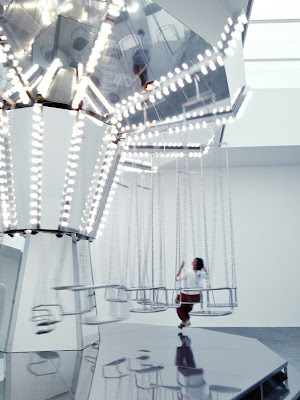A short line formed at the mouth of the slide and after getting clearance from the floors below, down the shoot they flew. Carsten Höller, originally trained as a scientist offers
Experience and it is just that. His goal is to stimulate the senses and whereas most art is visual only, he provides an external incentive for altered feeling and/or perception. In doing so, Höller has previously used psychotropic drugs, pulsating lights and altered architectural space to present an illusionist reality. Similar to his recent exhibit
Soma at the
Hamburger Bahnhof in Berlin this past year, once again small caged birds chirp adding an unexpected audio to the scene. Along with the chirping, clanking can be heard as one by one, guests slide down the silver tube. On the floor below those who choose, have the opportunity to disrobe for
Psycho Tank, 1999, an encased shallow pool filled with high salt content water and a specific filtration system that moves the body effortlessly in a circular formation.

Untitled (Slide), 2011, Installation view
Image courtesy of the New Museum
While waiting for his/her turn in the pool, those present can watch as the whoosh and clank of each person in the slide goes flying by. Carsten Höller: Experience, as a whole, is a minimal, clean, and quiet body of work. Each piece sits in space, specified for a certain task that can only be complete through human participation or accompaniment. It is in the silent moments when the work is at its strongest because each object exists as just that, a sculptural element. However in the realm of observation this art does not come with stipulations or restraint of having to look but not touch.
Walking from the fourth floor to the third, is Pill Clock, 2011, featuring gelatin pills that drop every 15 seconds along with a water cooler and cone shaped cups. The pills are nondescript and white. The coating makes a soft sound and several splash each time another pill is dropped. Overheard in the museum lobby, was a woman who jokingly mentioned taking one of the pills. In the presented format, it appears that may be the artist’s intention especially since there doesn’t seem to be a warning label or sign not to. Tempting as it may be, its not clear if this work is participatory or not.
What is Love, Art, Money?, 2011
Courtesy of the artist
Amongst several smaller works that are part of Experience, one worth returning to for a second glance is What is Love, Art, Money?, 2011. Installed on the fourth floor, along with Untitled (Slide) 2011, Mirror Carousel, 2005, and Singing Canaries Mobile, 2005, the three phones as shown above, are attached to an early 1990’s style Panasonic answering machine. Sans dial-tone, each phone will ring sporadically as the numbers have been distributed not only amongst employees of the museum, but also in Manhattan. The project allows for the phones to be called anonymously whereas the caller is not aware that he/she is dialing into the gallery of a museum. The piece lends itself to happenstance, chance encounters, and a hopeful disillusion of sorts.

Love Drug (PEA), 1993/2011, Glass vial and phenylethylamine
Courtesy of the artist
Carsten Höller: Experience not only partakes in a contemporary art dialogue but also raises the question of participation in art versus spectacle. Most art in the realm of a contemporary experience is not about having fun. However maybe the question he raises is not so much about enjoyment rather then tactile involvement. In a world where we are interacting less and less on a personal level, the physicality one can examine via these particular works is not only actual but can be relatively nostalgic in a format and venue that is all at once, completely new.
Carsten Höller: Experience will be on view from October 26, 2011-January 15, 2012, and is curated by Massimiliano Gioni, Associate Director and Director of Exhibitions, with Gary Carrion-Murayari, Associate Curator, and Jenny Moore, Assistant Curator.
More soon!
xo




